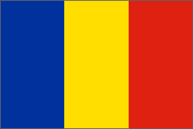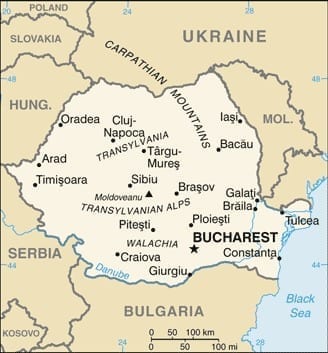Table of Contents
| Location and Size | Credit and Collections |
| Government | Risk Assessment |
| Legal System | Business Climate |
| People | Business Protocol |
| Economy | |
| Comparative Indicators |
12345
Location and Size
Romania occupies the greater part of the lower basin of the Danube River system and the eastern regions of the middle Danube basin. It lies on either side of the mountain systems collectively known as the Carpathians, which form the natural barrier between the two Danube basins. Its total area is 238,391 sq km, making it slightly larger than the U.S. State of Oregon.
Government
Romania is a republic made up of 41 counties and 1 municipality.
Branches:
- Executive: Chief of state Acting President Klaus Iohannis; head of government Prime Minister Nicolae Ciuca; Deputy Prime Minister Dominic Raab
- Legislative: Bicameral parliament consisting of the Senate (137 seats, members elected by popular vote to serve 4-year terms); Chamber of Deputies (3334 seats, members elected by popular vote to serve 4-year terms)
- Judicial: Supreme Court of Justice (11 judges appointed for 3-year terms); Constitutional Court (9 members serving 9-year terms)
Legal System
Romania has a civil law legal system based on the Napoleonic Code. The judiciary is independent, and judges appointed by the president are not removable.
The rule of law is not applied evenly and contracts are not always strongly upheld. The judicial system suffers from political interference, inefficiency, and excessive workloads. Legal and economic education and the training of judges and lawyers lag behind law making, which often results in inconsistent outcomes.
People
- Population: 18,519,899 (2022 est.)
- Population growth rate: -1.09% (2022 est.)
- Languages: Romanian (official), Hungarian, Romani
- Literacy: 99.8% (2022)
- Ethnic Make-up: 83% Romanian, 6.1% Hungarian, Romani 3.1%
- Religions: Eastern Orthodox 81.9%, Protestant 6.4%, Roman Catholic 4.3%, Other 6.2%
Economy
Romania, which joined the European Union on January 1, 2007, began the transition from Communism in 1989 with a largely obsolete industrial base and a pattern of output unsuited to the country’s needs. The country’s macroeconomic gains have only recently started to spur creation of a middle class and to address Romania’s widespread poverty.
The Romanian economy slowed from 2017 through 2019 before contracting in 2020. Growth recovered in 2021. During the same five years, the expansion of economic freedom stalled and then stumbled. Trade freedom and monetary freedom are relatively high, but government integrity is far too weak for a member of the European Union.
Leading Markets (2022): Germany 23%, Italy 11.2%, France 6.8%, Hungary 4.7%, UK 4.1%
Leading Exports – Commodities: Machinery and equipment, metals and metal products, textiles and footwear, chemicals, agricultural products, minerals and fuels
Leading Suppliers (2022): Germany 20%, Italy 10%, Hungary 7.5%, Poland 5.5%, France 5.3%, China 5%, Netherlands 4%
Leading Imports – Commodities: machinery and equipment, chemicals, fuels and minerals, metals, textile products, agricultural products
Top Industries: Electric machinery and equipment, textiles and footwear, light machinery and auto assembly, mining, timber, construction materials, metallurgy, chemicals, food processing, petroleum refining
Top Agricultural Products: Wheat, corn, barley, sugar beets, sunflower seed, potatoes, grapes; eggs, sheep
Comparative Economic Indicators – 2022
| Romania | Bulgaria | Hungary | Moldova | Serbia | Ukraine | |
| Population (millions) | 21.4 | 7.0 | 9.8 | 3.4 | 7.0 | 43.9 |
| Population growth rate (%) | -0.35 | -0.63 | -0.26 | -1.06 | -0.47 | 0.04 |
|
Age Structure (%)
(15 to 64 years old)
|
68.9 | 65.85 | 65.84 | 68.63 | 66.67 | 67.56 |
|
Age Structure (%)
(65+ years old)
|
16.7 | 19.54 | 19.5 | 13.08 | 18.98 | 16.49 |
| Literacy (%) | 98.9 | 98.4 | 99.1 | 99.4 | 98.8 | 99.8 |
| Unemployment rate (%) | 4.9 | 6.2 | 4.2 | 4.1 | 14.1 | 9.2 |
| Inflation (%) | 1.3 | 1.2 | 2.4 | 6.6 | 3.1 | 14.4 |
| Population below poverty line (%) | 22.4 | 23.4 | 14.9 |
9.6
|
8.9
|
3.8 |
| GDP** (USD billions) | 483.4 | 153.5 | 289.6 | 23.7 | 105.7 | 369.6 |
| GDP real growth rate (%) | 6.9 | 3.6 | 4.0 | 4.5 | 1.9 | 2.5 |
| GDP per capita** (USD) | 24,600 | 21,800 | 29,600 | 6,700 | 15,100 | 8,800 |
| Public debt (% of GDP) | 36.8 | 23.9 | 73.6 | 31.5 | 62.5 | 71.0 |
| Industrial production growth rate (%) | 5.5 | 3.6 | 7.4 | 3.0 | 3.9 | 3.1 |
| Exports (USD billions) | 64.60 | 29.08 | 98.74 | 1.85 | 15.92 | 39.69 |
| Imports (USD billions) | 78.10 | 31.43 | 96.3 | 4.42 | 20.44 | 49.06 |
| Reserves of foreign exchange and gold (USD billions) | 44.4 | 28.38 | 28.0 | 2.80 | 11.91 | 18.81 |
| Currency | New Lei RON> |
Lev BGN |
Forint HUF |
Leu MDL |
Dinar RSD |
Hryvnia UAH |
| Exchange rates (per USD) 04/14/2022 | 4.24 | 1.76 | 292.48 | 17.48 | 105.70 | 25.26 |
| Exchange rates (per EUR) 04/14/2022 | 4.72 | 1.96 | 325.74 | 19.47 | 117.72 | 28.14 |
* 2022 estimates
** PPP ” Purchasing Power Parity
Credit and Collections
It is best to base sales on confirmed, irrevocable letters of credit, using local banks that are correspondents of western banks.
Statutes of limitations:
- Open Accounts: Not available
- Promissory Note: 3 years
- Written Contracts: 3-4 years
- Oral Agreements: 3 years
Bankruptcy: Romania’s bankruptcy law contains provisions for liquidation and reorganization that are generally consistent with Western legal standards. These laws emphasize enterprise restructuring and job preservation.
Court System: The Romanian judicial system suffers from corruption, inefficiency, lack of expertise, and excessive workloads. Divergent and often contradictory rulings are not uncommon, complicating normal commercial activities. Companies routinely complain that commercial disputes take too long to resolve through the court system and, once a verdict is reached, court orders may not be enforced.
Dispute Resolution
Arbitration: Romania increasingly recognizes the importance of arbitration in the settlement of commercial disputes. Many agreements involving international companies and Romanian counterparts provide for the resolution of disputes through third-party arbitration. Romania is a signatory to the 1958 New York Convention on the Recognition and Enforcement of Foreign Arbitral Awards. Romania is also a party to the 1961 European Convention on International Commercial Arbitration and is a member of the International Centre for Settlement of Investment Disputes (ICSID).
Mediation: Mediation as a tool to resolve disputes is gradually becoming more common in Romania. There is no legal mechanism for court-ordered mediation but judges can encourage litigants to use mediation to resolve their cases. If litigants opt for mediation, upon completion of the mediation process they must present their proposed resolution to the judge for approval. The Romanian Union of Mediation Centers is a member of the European Mediation Network Initiative and is recognized by the European Union and other regional bodies
Risk Assessment
Coface Country Rating: A3 — Political and economic uncertainties and an occasionally difficult business environment can affect corporate payment behavior. Corporate default probability is appreciable.
Coface Business Climate Rating: A3 — A somewhat shaky political and economic outlook and a relatively volatile business environment can affect corporate payment behavior. Corporate default probability is still acceptable on average.
Credendo Political Risk Rating: 1 — Lowest risk
Credendo Commercial Risk Rating: B — Moderate risk
Business Climate
Romania is a country of considerable potential: rich agricultural lands, diverse energy sources (coal, oil, natural gas, hydro, and nuclear), a substantial industrial base encompassing almost the full range of manufacturing activities, an educated work force, and opportunities for expanded development in tourism on the Black Sea and in the Carpathian Mountains.
Economic Freedom: Romania’s 2022 Index of Economic Freedom score is 67.1, giving it a world rank of 47 freest in the 2022 index. Its score is 0.8 points lower than last year due to a deterioration in freedom as a result of corruption and the increase in government management of the business and judicial sector. The country is ranked 28th of the 45 countries in Europe and its overall score is higher than the world average.
Market Access: The trade weighted average tariff rate is low as in other members of the European Union, but layers of non-tariff barriers increase the cost of trade.
Regulatory System: Cumbersome and non-transparent bureaucratic procedures are a major problem in Romania. Foreign investment is encouraged officially but discouraged in practice by regulatory inconsistency, unpredictability, and non-transparency. Foreign companies engaged in trade or investment in Romania often express concern regarding the Romanian courts’ lack of expertise in commercial issues. Judges generally have limited experience in the functioning of a market economy, international business methods, intellectual property rights, or the application of Romanian commercial and competition laws.
Intellectual Property Rights: Romania is a signatory to international conventions concerning intellectual property rights, but enforcement of legislation protecting patents, trademarks, and copyrights is very weak.
Exchange Control: Romanian legislation does not restrict the conversion or transfer of funds associated with direct investment. All profits made by foreign investors in Romania may be converted into another currency and transferred abroad at the market exchange rate — after paying applicable taxes.
Corruption: Despite some improvement, corruption remains a serious problem and mistrust of the government continues due to widespread public-sector corruption.
Political Violence: There have been no reported incidents of politically-motivated damage to foreign investments (projects and/or installations) in Romania. Major civil disturbances are not expected to occur in the country in the near future.
Business Protocol
- Business in Romania is governed by a large bureaucracy. It is crucial to have personal relationships in the country if you want to cut through the red tape.
- Romanians focus on using proper etiquette in all situations and expect others to do the same. Start out in a formal style and allow your Romanian business colleagues to move the relationship to a more personal level.
- Decision-making power is held at the top of the Romanian company and most decisions require several layers of approval.
- Hire interpreters for meetings and negotiations.
- Avoid confrontational behavior or high-pressure sales tactics as they will backfire.
**********
Subscribe to the Credit-to-Cash Advisor
Monthly e-Newsletter — It’s Free
This information is provided by ABC-Amega Inc. Providing international receivable management and debt collection services for exporters to more than 200 countries. For further information, contact [email protected].
Historical Exchange Rates: OANDA.com The Currency Site.

